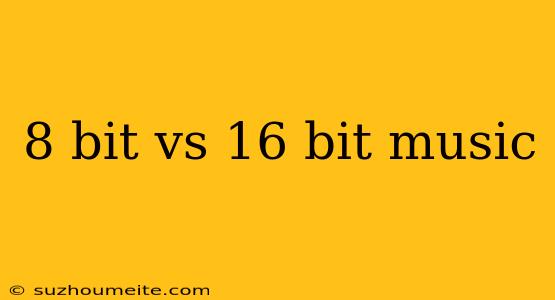8-bit vs 16-bit Music: A Dive into the Digital Audio Landscape
The world of digital music is filled with diverse soundscapes, each carrying its unique sonic fingerprint. One of the key distinctions that often arises is the difference between 8-bit and 16-bit music. Understanding this difference helps us appreciate the evolution of digital audio and the unique qualities of each format.
8-bit Music: The Dawn of Digital Sound
8-bit music emerged alongside the first generation of personal computers, primarily in the 1980s. It is characterized by its limited sonic palette due to the constraints of early technology. 8-bit systems had restricted processing power and limited memory, resulting in a reduced number of bits available to represent each sample of audio.
Here are some defining characteristics of 8-bit music:
- Simple, Chiptune-Like Sounds: The limited capabilities of 8-bit sound chips resulted in basic, repetitive sounds, often with a square wave or pulse wave form. These sounds became synonymous with the era, lending a distinctive character to games like Super Mario Bros. and Mega Man.
- Limited Dynamic Range: The small number of bits meant a restricted dynamic range, limiting the volume differences between the loudest and quietest parts of the music. This resulted in a compressed and often "bright" sound.
- Noisy and Imperfect: The limitations of the hardware could lead to audible artifacts, like quantization noise or aliasing. These imperfections added a unique character to the music, often perceived as part of its charm.
16-bit Music: Expanding the Audio Landscape
16-bit music, introduced later, represented a significant leap forward in digital audio quality. This shift was driven by advancements in technology, resulting in increased processing power and larger memory capacities.
Here's how 16-bit music distinguishes itself:
- Expanded Dynamic Range: The doubled bit depth allowed for a much wider dynamic range, enabling greater variations in volume and more nuanced audio detail.
- Smoother and More Complex Sounds: 16-bit music could accommodate more complex waveforms, leading to richer, smoother, and more natural sounds. This allowed for a wider range of musical expression and instrumentation.
- Improved Fidelity: The increased bit depth resulted in less noise and distortion, leading to a cleaner and more accurate representation of the original audio source.
The Legacy of 8-bit Music
Despite the technical limitations, 8-bit music has left an enduring legacy. Its distinctive sound continues to inspire musicians and game developers, influencing genres like chiptune and retro gaming. It's often used for nostalgic purposes, evoking memories of a bygone era.
Beyond the Bits: A Matter of Perspective
The choice between 8-bit and 16-bit music is ultimately a matter of preference. While 16-bit offers higher fidelity and technical advantages, 8-bit music retains its unique charm and nostalgic appeal. Both formats have their place in the landscape of digital audio, offering distinct sonic experiences and creative possibilities.
